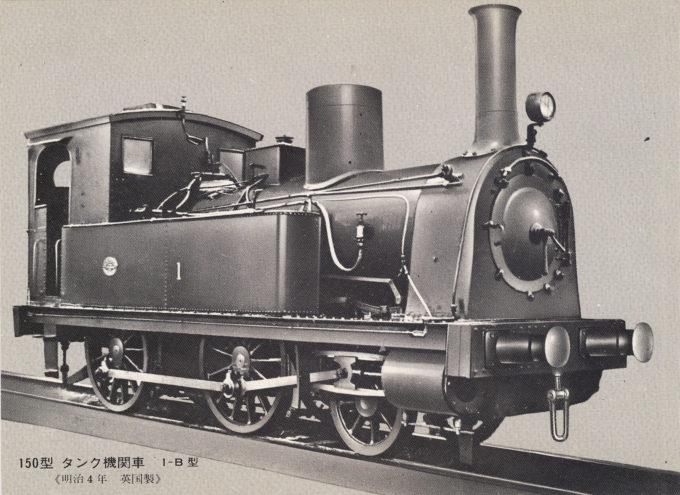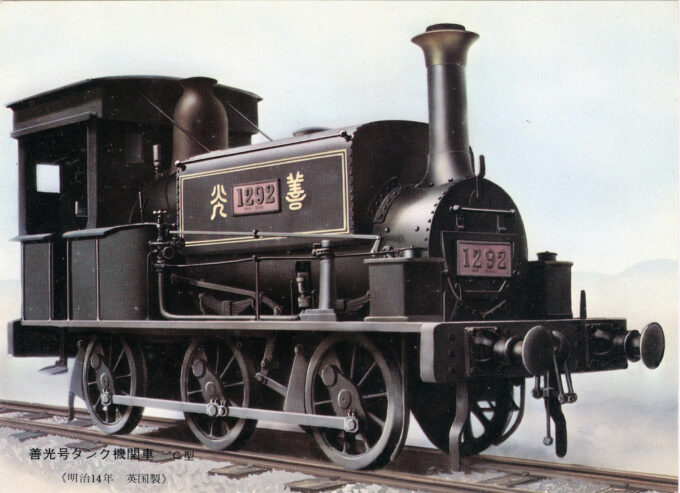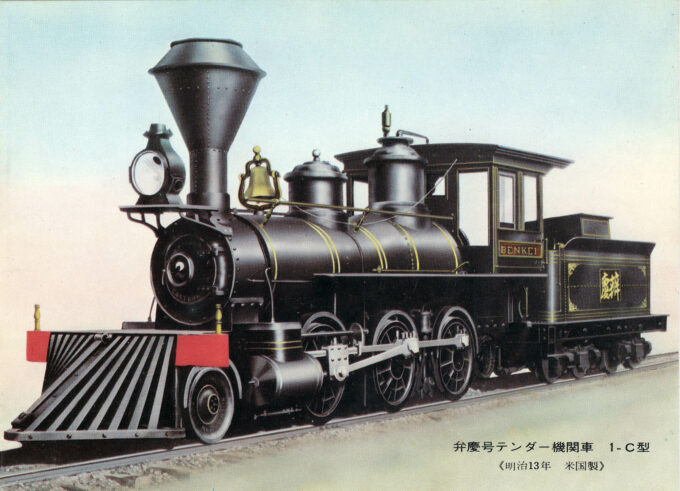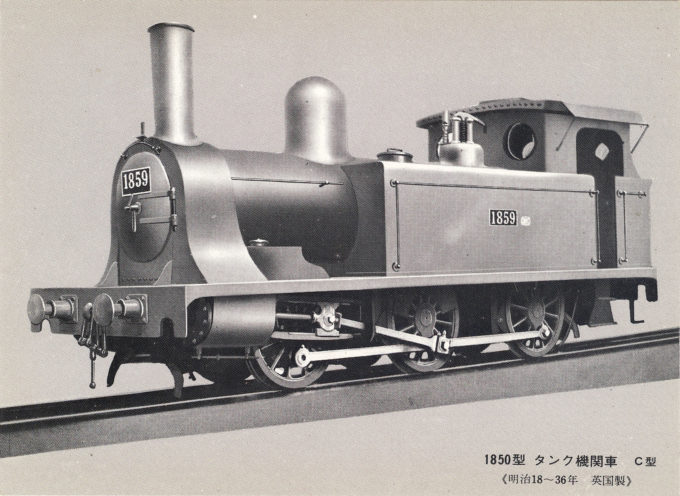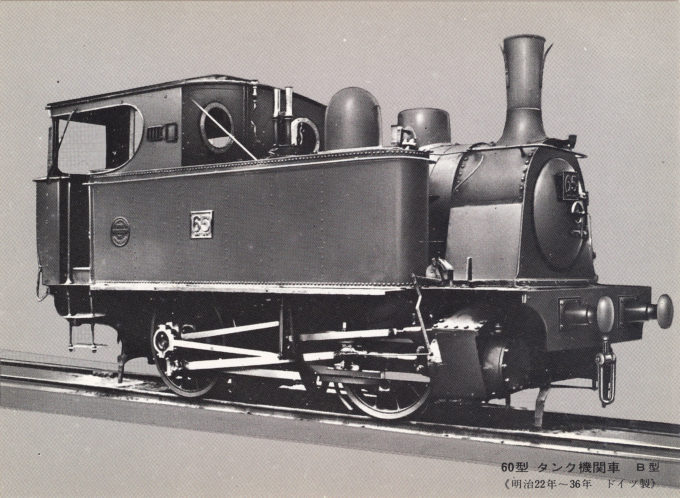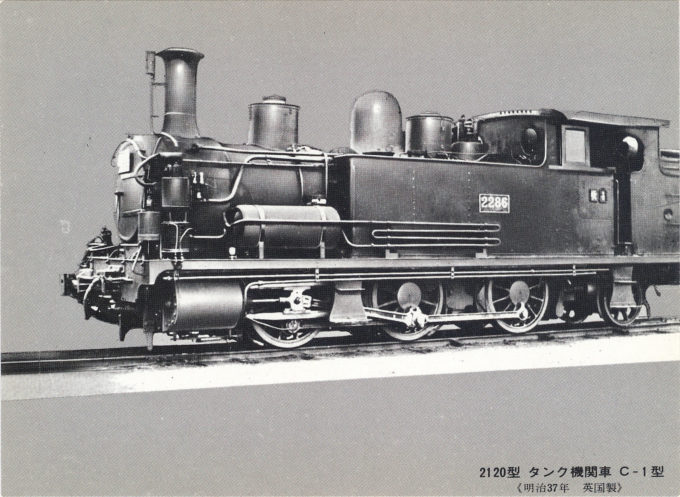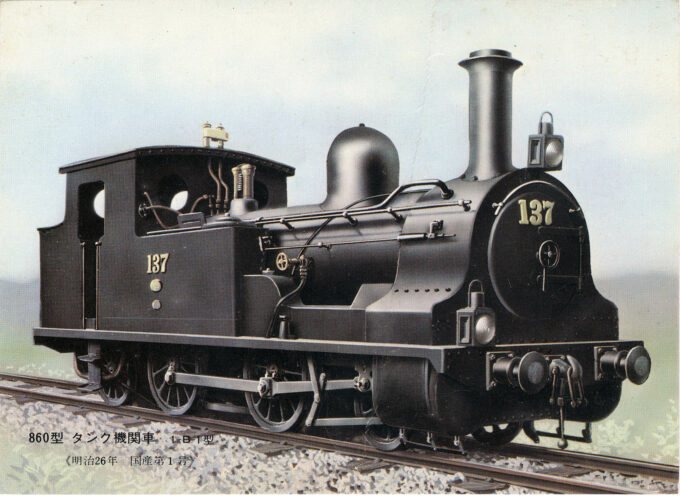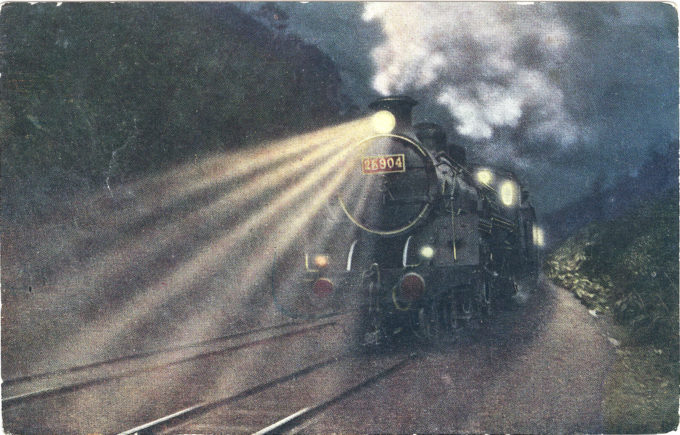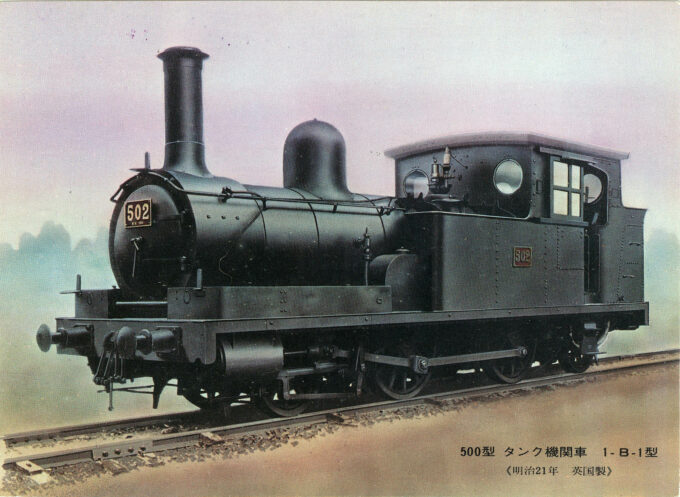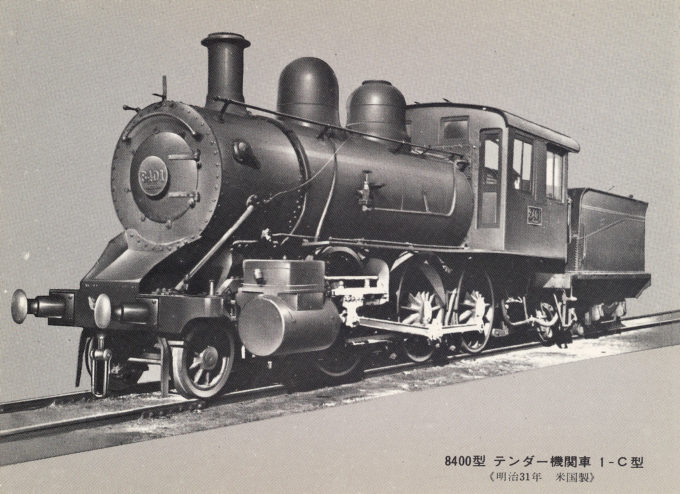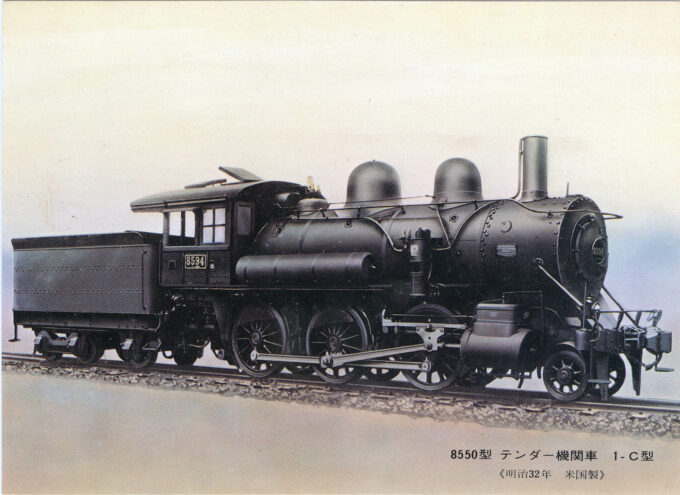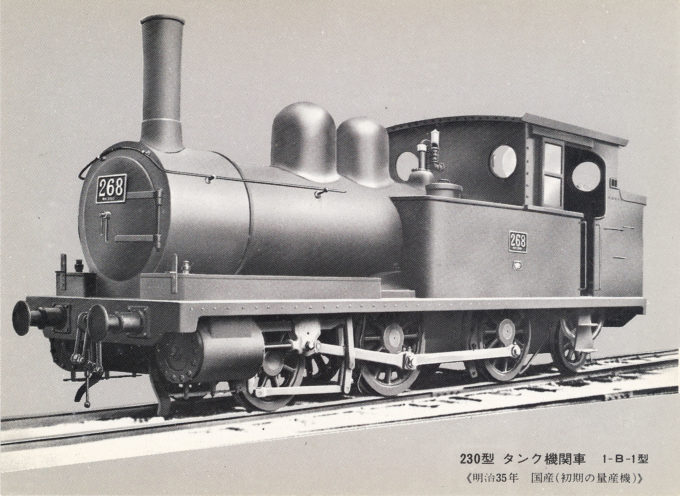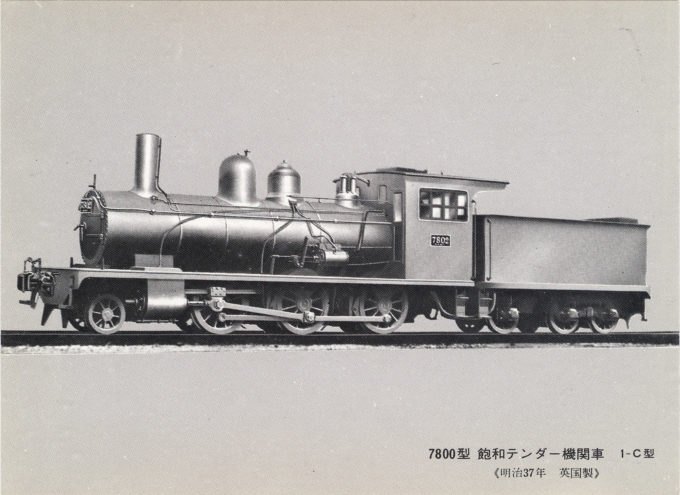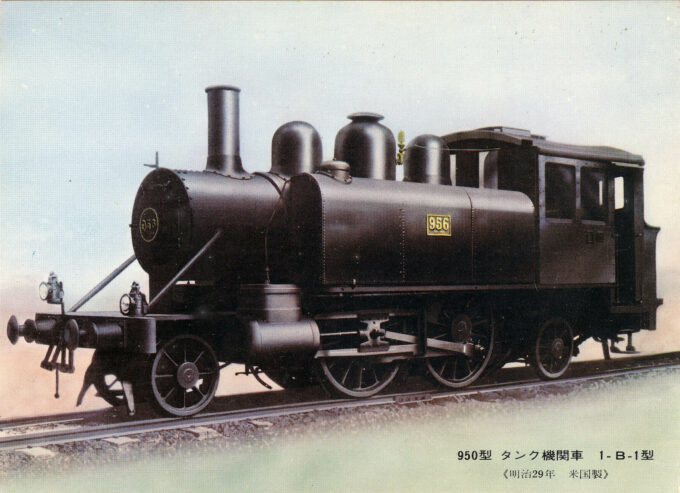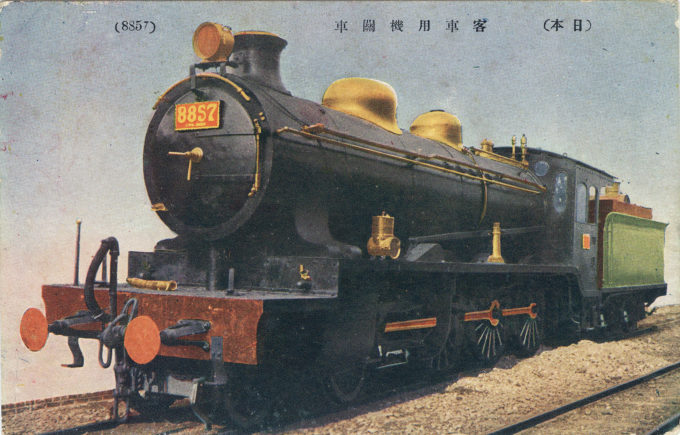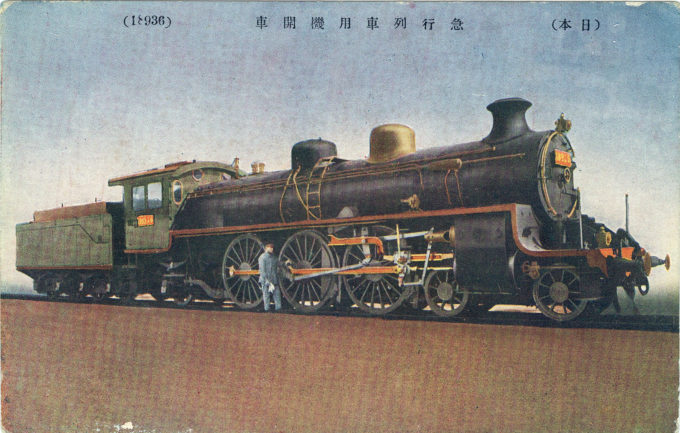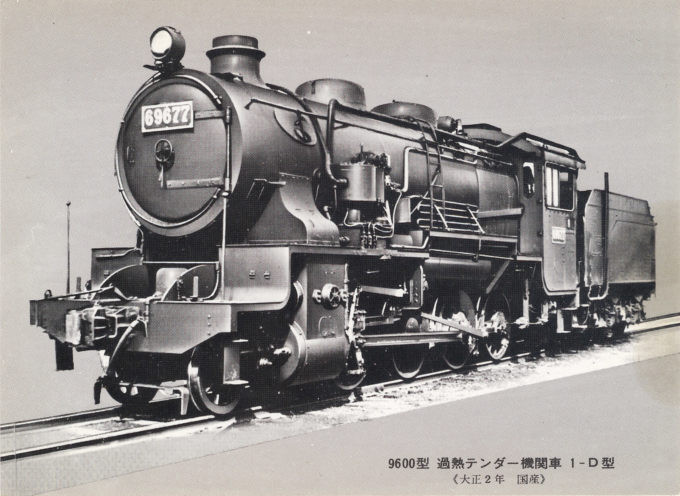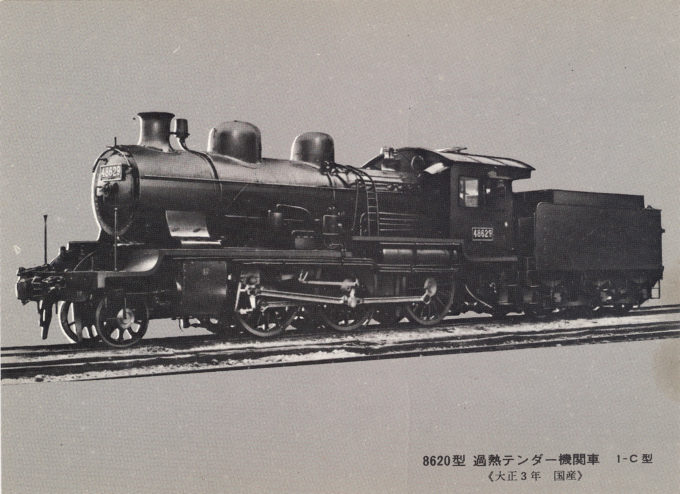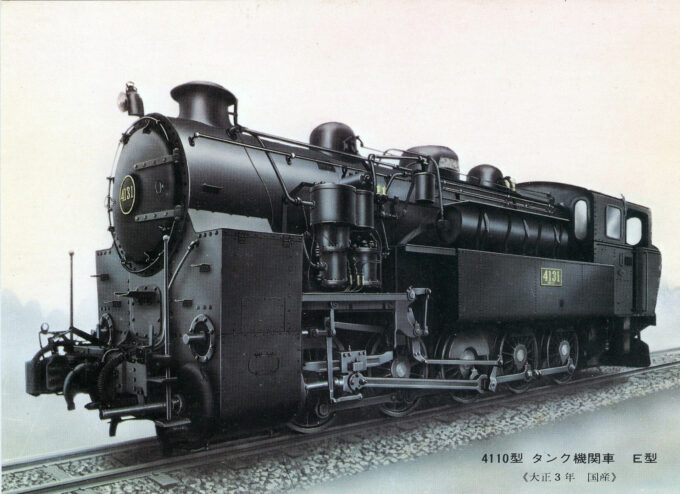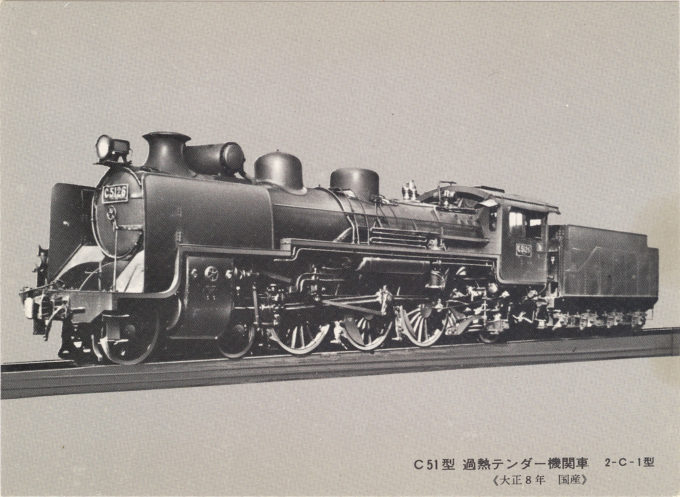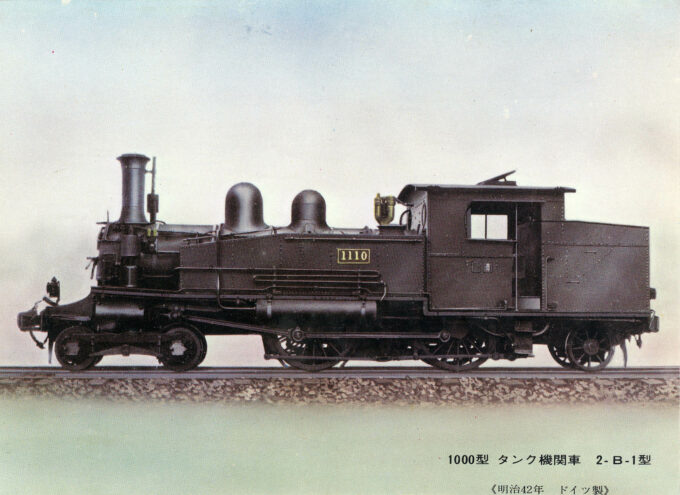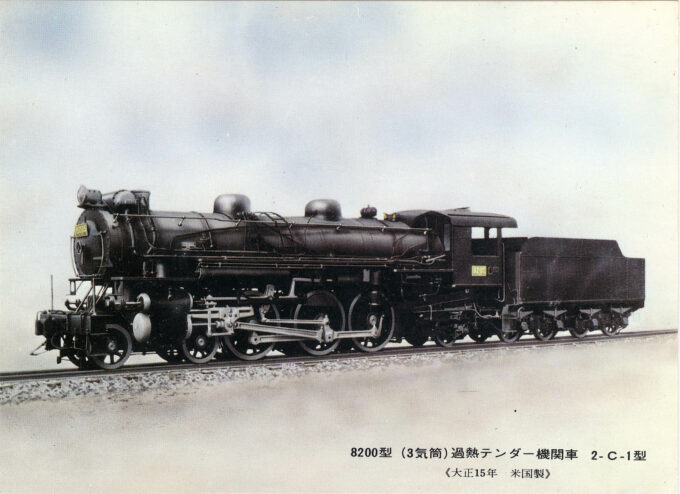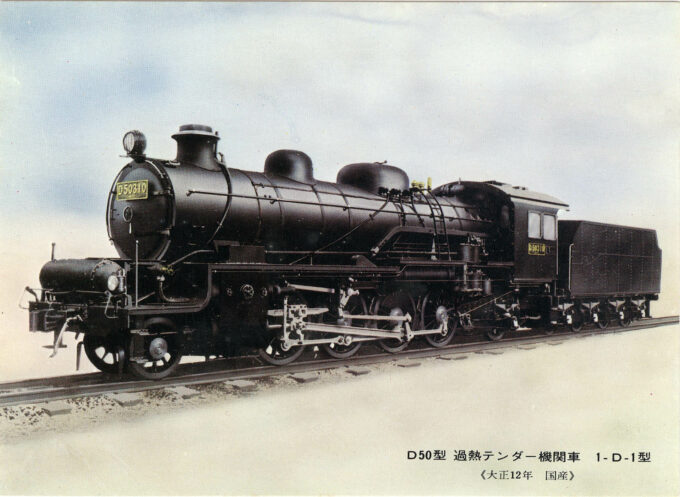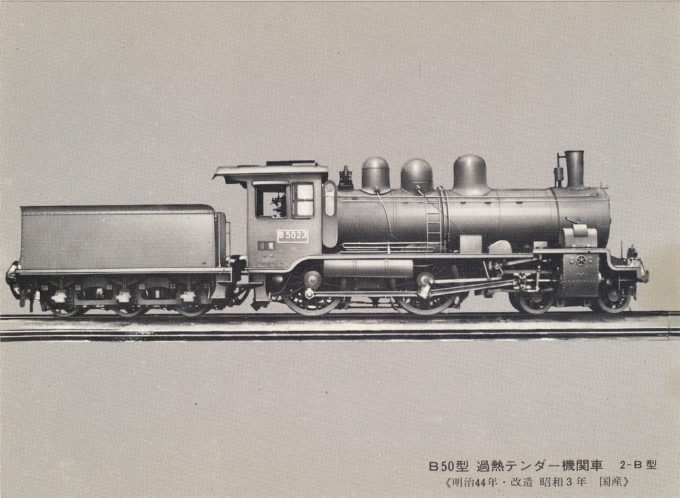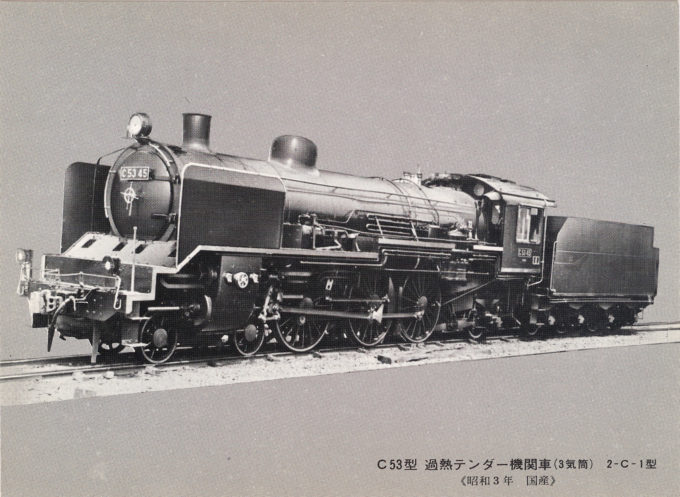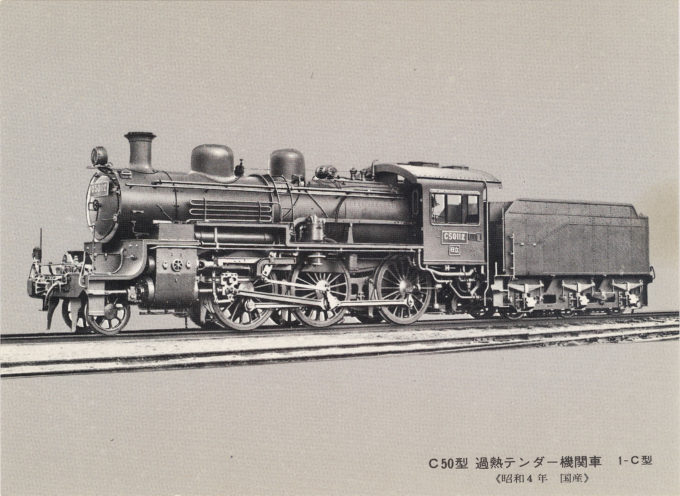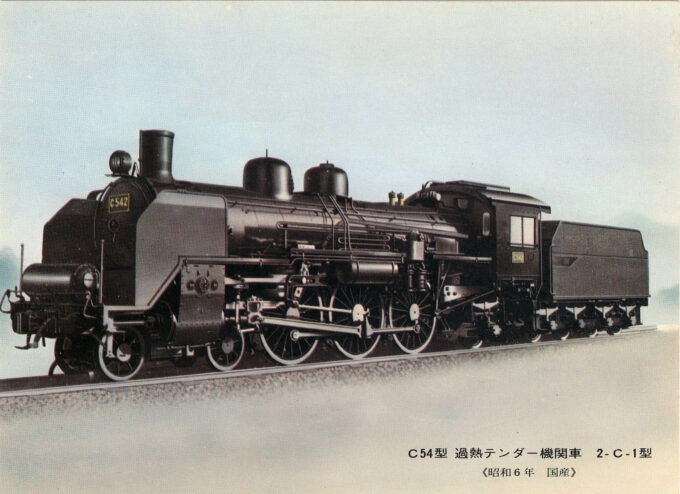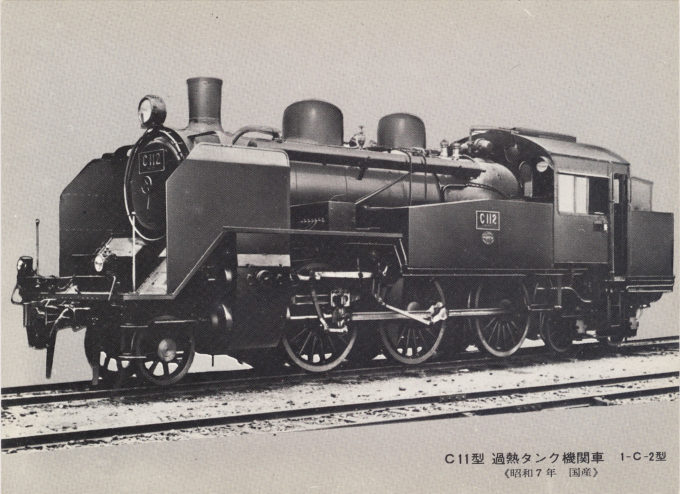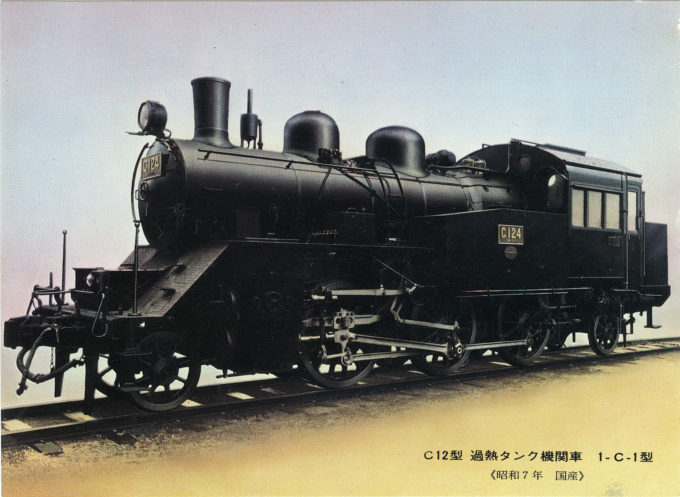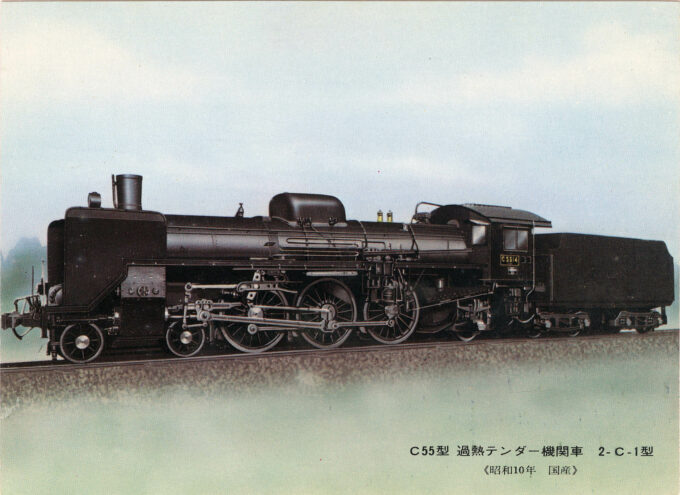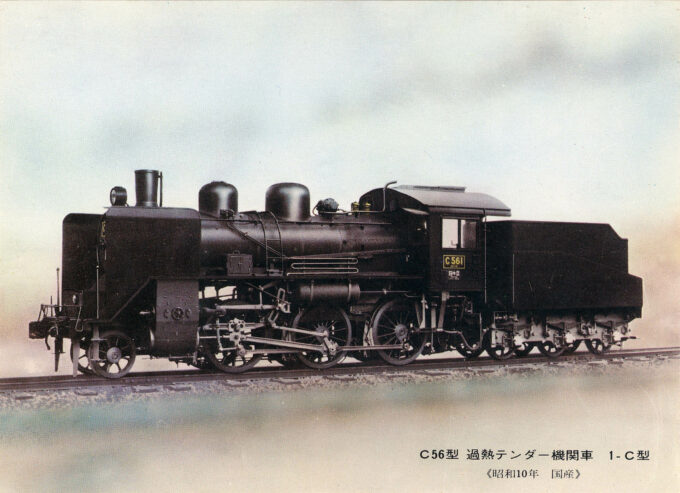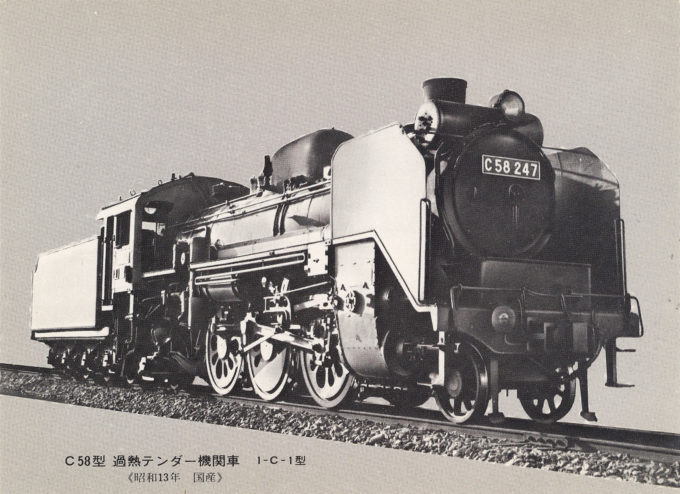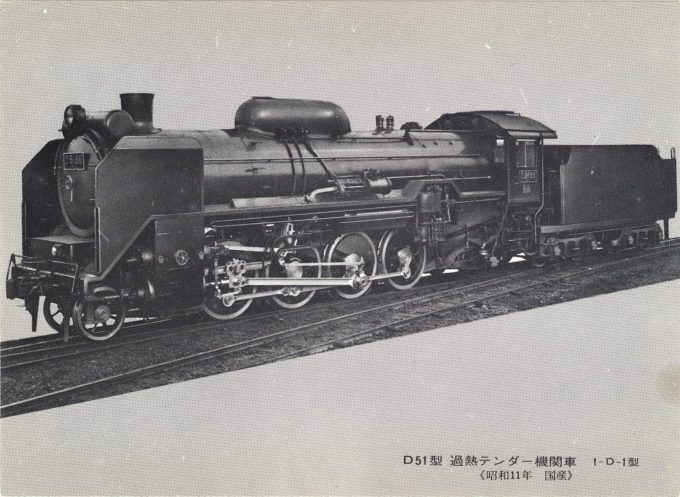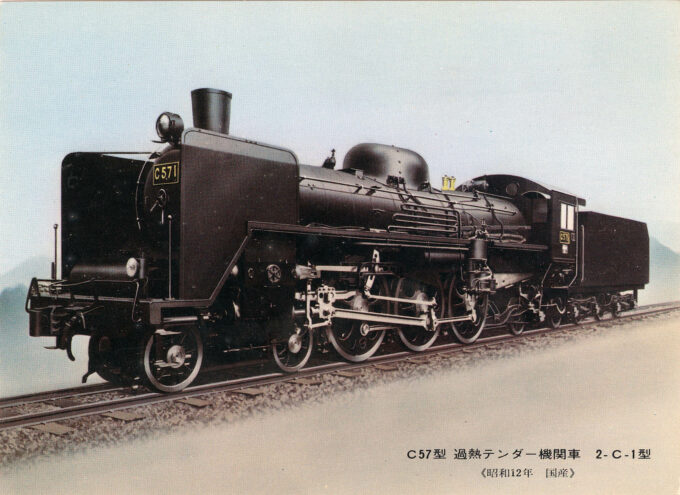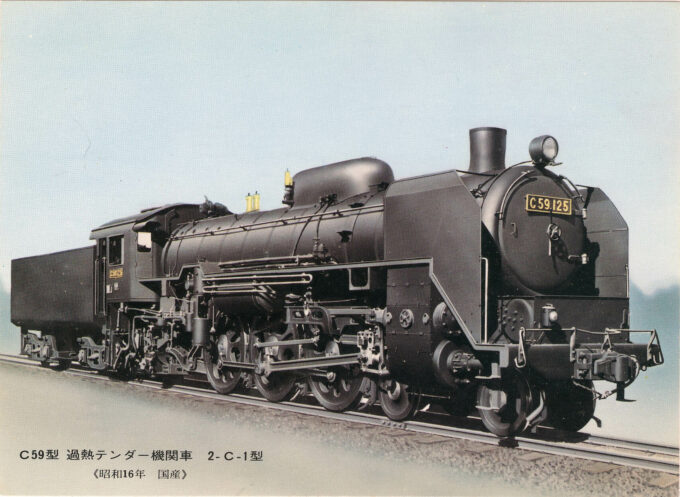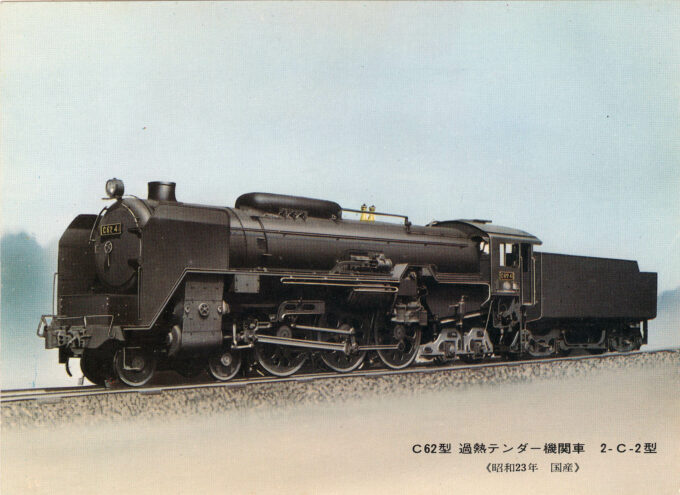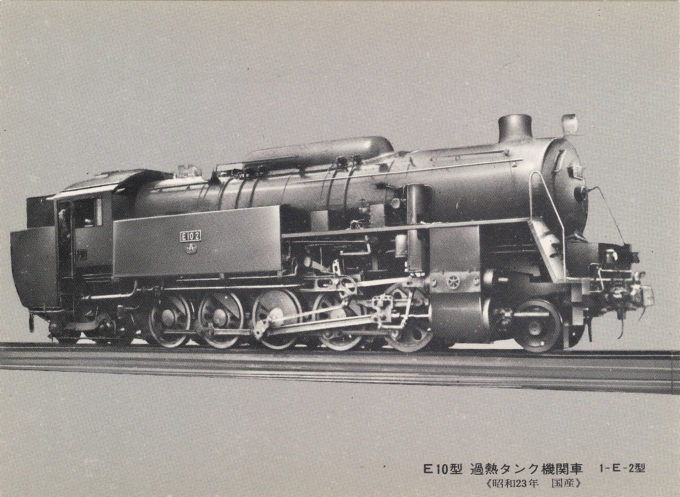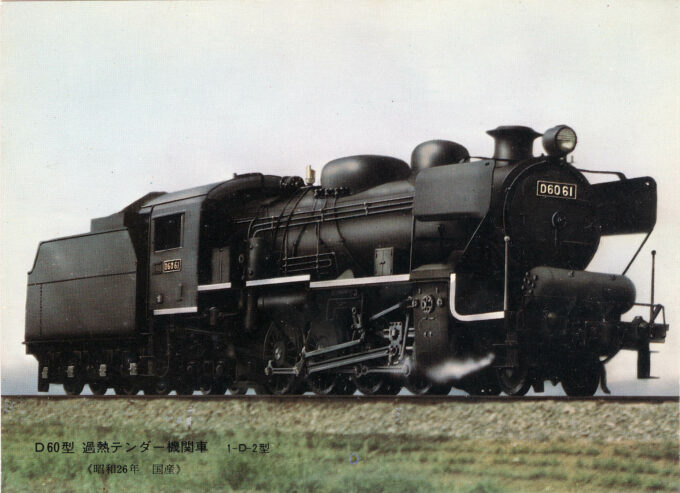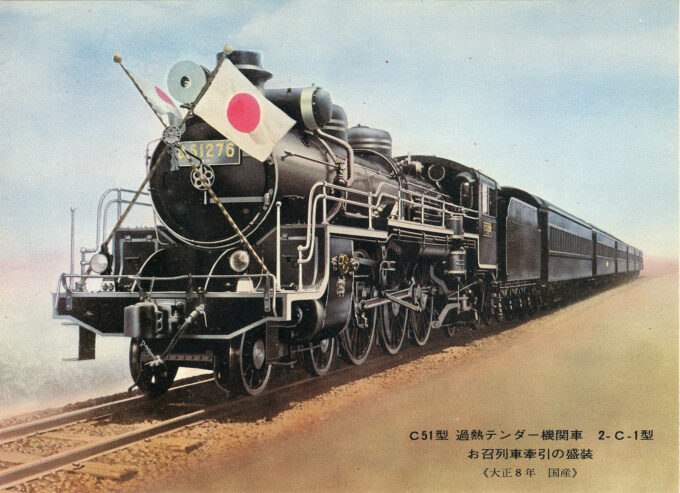
JGR/JNR Class C51. (1919-1966) Decked out with polished brass and chrome, from 1920 until its retirement in 1966, C51276 was placed in service to pull the Imperial rail carriages.
See also:
C55 Streamlined Locomotive and Mt. Fuji, c. 1940.
“5000 Miles of Railway in Japan” commemorative postcard, Nagoya, 1906.
50th Anniversary Commemoration, Imperial Government Railways, 1922.
“Two early encounters with steam locomotives piqued Japanese interest in the technology.
“One month after Commodore Matthew Perry’s ‘Black Ship’ squadron first appeared off the Japanese coast at Shimoda to deliver a message from the U.S. government demanding the establishment of trade relations with Japan, ships under the command of E.V. Putyatin of the Imperial Russian Navy dropped anchor off Nagasaki for much the same purpose, bearing gifts as an enticement, among them a small alcohol-fired model of a railroad steam locomotive and carriages about the size of a large toy.
“… When Cmdr. Perry reappeared in February, 1854, this time off the Miura Peninsula in much closer proximity to the capital, Edo, to receive his demanded reply, he too brought with him gifts [among them] a fully functional 1/4-scale wood-fired steam locomotive, tender and a passenger car, and one mile of circular track, which his crew set up on the beach at [Uraga].
“As recalled in the official history of the Perry excursion,
‘All the parts of the mechanism were perfect, and the car was a most tasteful specimen of workmanship, but so small that it could hardly carry a child of six years of age.
‘The Japanese, however, were not to be cheated out of a ride and, as they were unable to reduce themselves to the capacity of the inside of the carriage, they betook themselves to the roof.
‘It was a spectacle not a little ludicrous to behold a dignified mandarin whirling around the circular road at a rate of twenty miles an hour, with his loose robes flying in the wind.’
– Early Japanese Railways, 1853-1914, by Dan Free, 2008
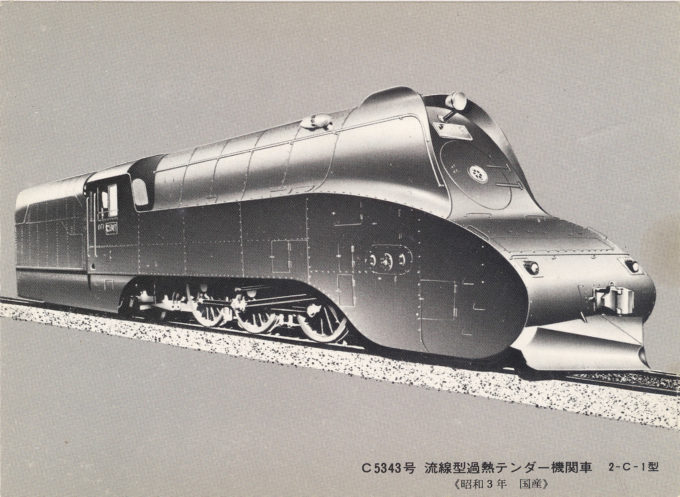
C5343 Streamliner, the only Class C53 locomotive converted to a streamlined profile. It was posted for Tokaido Main Line express service between Nagoya and Kobe. The extra costs of retrofitting existing units outweighed the benefit of any increase in speed. Only a dozen locomotives (the others were mostly Class C55 conversions) were streamlined before the program ended with the outbreak of war. Valuable data was being collected nonetheless that would later be collated into the creation of the Shinkansen in 1964.
1872-1899
The Class 150 was the first steam locomotive class to operate in Japan. Only one was imported by the Japanese government before the opening of Japan’s first railroad. Locomotive No. 1, manufactured by Vulcan Foundry, Lancashire, UK, began running on 14 October 1872 between Sakuragicho (Yokohama) and Shimbashi (Tokyo). After being used for about eight years, in November 1880 the locomotive was transferred to the Kobe area of what would later become the Tōkaidō Main Line. From 1885, Locomotive No. 1’s duties were reduced to railyard shunting service. The JGR continued to operate it until 1911 when it was sold to and operated by Shimabara Railway. In 1930, Locomotive No. 1 was then sold back to the JGR for use as a museum piece and put on display at the original Transportation Museum at Manseibashi, Tokyo. It remains today on display at the Railway Museum in Saitama Prefecture. In 1997, Locomotive No. 1 became Japan’s first railway vehicle to be designated as a national Important Cultural Property.
The Class 1290 was a 0-6-0T Switcher-type saddle tank steam locomotive operated by the Japanese Government Railways from 1875 to 1930. It was one of the first class of steam locomotives to operate commercially in Japan. First ordered in 1873 by the JGR, two locomotives were built by Manning Wardle and Company in the United Kingdom in 1873 and imported into Japan in 1875. One Class 1290, 1292, the locomotive nicknamed “Zenkō”, survives today at the Railway Museum in Saitama.
The Class 7100 was a 2-6-0 Mogul-type steam locomotive manufactured by H.K. Porter, Inc. of the United States. It was first operated by the Hokkaido Government Railway and then by Japanese Government Railways in Hokkaido from 1880 to 1915. The first six Class 7100 locomotives imported between 1880-1885 were the first locomotives in Japan to be given special monikers (in this case, historical and literary luminaries), a similar naming trend with U.S. and Canadian railroads at the time, such as Yoshitsune, Mitsukuni, and Shizuka.
The Class 1800 was a 0-6-0T Switcher-type side tank steam locomotives operated by the Japanese Government Railways. Thirteen locomotives were initially ordered for the JGR from Kitson and Company, West Yorkshire, England, operating from 1881 until the last locomotive was retired in 1938. But four were later reactivated and and put back into service during World War II, serving until 1949. One example remains today on display at the Kyoto Railway Museum.
The Class 80 was a 0-4-0T Switcher-type side tank steam locomotive, with three locomotives built by Hohenzollern Locomotive Works of Germany in 1889 and imported into Japan to begin work with the Sanuki Railway (later to become the San’yo Railway). Operated by the JGR until 1923, the locomotives were sold to various factories where they continued factory yard service until scrapped in 1964.
The Class 2100 were 0-6-2T Webb-type side tank steam locomotives built for the JGR from 1890 to 1905, imported from the United Kingdom or Germany for use mainly as freight locomotives. Some saw service until 1953. Nicknamed ikazuchi (“thunder”), several have survived as museum pieces with one remaining operational today at the Nippon Institute of Technology in Saitama. This locomotive class also saw service in Taiwan and Manchuria (Manchukuo) during the pre-war era.
The Class 860 was a 2-4-2T Columbian-type compound side tank steam locomotive operated by the Japanese Government Railways from 1893 to 1929, most notable because it was the first domestically-produced locomotive in Japan.
The Class 5900 (originally the Sanyo Railway Class 12) was a 4-4-0 American-type steam locomotive operated by the Japanese Government Railways from 1897 to 1932. A total of twenty-eight locomotives were manufactured by the Baldwin Locomotive Works in 1897-1901. These locomotives were used to haul express passenger trains at high speeds. Retirements began in 1925 and all were retired by 1932, with none sold to private railroads. No Class 5900s have been preserved.
The Class 400 and associated classes — 500, 600, 700 — were groups of 2-4-2 Columbian-type side tank steam locomotives built for the national railroad and various private railways in Japan from 1886 to 1899. Used mainly for mixed traffic duty, the Class 400 began one of the first and largest locomotive series used on the Japanese railway system. Some locomotives remained in service for a long time in the hands of several operators. By 1951, all locomotives had been withdrawn from the Government railway systems.
The Class 8400 (originally the Sanyo Railway Class 14) was a 2-6-0 Mogul-type steam locomotive manufactured by Roger Locomotive Works using blueprints from Baldwin Locomotive Works, four of which were imported into Japan beginning in 1898. The 8400s were mainly used as freight locomotives but little is known about the locomotive’s service history. The locomotives were retired in 1934. No locomotives survived into preservation.
The Class 8550 and the related JGR Class 8500 were 2-6-0 Mogul-type steam locomotives operated by the Japanese Government Railways from 1899 to about 1945. The type was ordered by the Kyushu Railway as the Class 154 (renumbered in 1906), of which sixty-one locomotives were built by the American Locomotive Company. These were mainly used by the Kyushu Railway as freight locomotives.
No Class 8550s have been preserved.
1900-1924
The Class 230 was a 2-4-2T Columbian-type side tank steam locomotive built from 1902 to 1909, used mainly as freight locomotives. The 230s were known as the first domestically mass-produced steam locomotive; their design based on locomotives made by Dübs & Co., Wilson & Co., Ltd. and the Vulcan Foundry in the United Kingdom.
The Class 7800 (originally the Hokkaido Railway Class C2) was a 2-6-0 Mogul-type steam locomotive operated by the Japanese Government Railways from 1904 to 1932. A total of six locomotives manufactured by the North British Locomotive Company of Glasglow, United Kingdom. The locomotives were used in Hokkaido throughout their service lives. The locomotives were retired by 1927. No Class 7800s have been preserved.
The Class 950 was a 2-4-2T Columbian-type side tank steam locomotive operated by the Japanese Government Railways from 1906 to 1935. Ten locomotives were built by the Baldwin Locomotive Works. One Class 950 was converted into a tender locomotive around 1909. After the Railway Nationalization Act was passed in 1909, the locomotives were renumbered the Class 950.
Retired in 1935, no Class 950s have been preserved.
The Class 8800 was a 4-6-0 Ten-Wheeler-type superheated fast passenger steam locomotive operated by the Japanese Government Railways from 1911 to 1950. The type was ordered by the JGR in 1911, with a total of twelve locomotives manufactured by Berliner Maschinenbau AG of Germany and imported into Japan. Used in the Kinki Region, all Class 8800 locomotives were based in Kobe. The locomotive was graded as having excellent performance and as such superheating was adopted for all future steam locomotives.
The Class 8900 was a 4-6-2 Pacific-type superheated steam locomotive operated by the Japanese Government Railways from June 1912 to 1932. A total of thirty-six locomotives were ordered by the Japanese Government Railways from the American Locomotive Company. The locomotives were estimated to have been used until 1932 when they were retired after having had the shortest services lives of the four competing locomotives (vs. Class 8700, 8800 and 8850), but did form the basis for the successful Class C51 locomotives.
The Class 9600 was a type of 2-8-0 steam locomotive and operated by the Japan Government Railways and, later, Japan National Railways from 1913 to 1976. Class 9600s were the first locomotive type to be mass-produced by Japanese manufacturers. Popularly known as kyuroku (nine-six), the Class 9600 was extensively used for freight service throughout Japan and pre-war service in Formosa (Taiwan). Over 250 Class 9600 locomotives were also sent to China after the Pacific War, becoming China Railway Class KD55.
The Class 8620 was a 2-6-0 steam locomotive built from 1914 to 1929. It was Japan’s first mass-produced passenger locomotive. A total of 672 Class 8620 locomotives were built. As of 2014, twenty Class 8620 locomotives have been preserved in Japan, including one preserved in working order at the Kyoto Railway Museum, Kyoto.
The Class 4110 were used mainly as freight locomotives and was able to cope with very steep gradients coupled with practically unheard of strength with regards to pulling power. The 4110s were essentially domestically manufactured copies of the Class 4100 locomotives made by Maffei in Germany, with thirty-nine built by the Kawasaki Shipyards. The locomotives were retired in 1950 after being replaced by the Class E10s in their duties.
The Class C51 was a type of 4-6-2 steam locomotive (The C classification indicates three sets of driving wheels) operated by Japan Government Railways beginning in 1919. A total of 289 were manufactured between 1919-1928, and the locomotives remained in operation until 1976. The C51s raised the average speed on the Tōkaidō Main Line from 47.3 km/h (29.4 mph) to 55.3 km/h (34.4 mph). In 1930, a C51 hauled the first Tsubame (Swallow) express, reducing travel time between Tokyo and Kōbe to 9 hours.
1925-1945
The Class 1070 was one of a number of tank locomotive conversions of existing tender locomotives undertaken by the JGR in their later years. 49 Class 6200 and 6270 locomotives were converted into Class 1070 locomotives by JGR’s various plants, mainly in Ōmiya and Takatori. The locomotives were converted from 1925 to 1928 and renumbered from 1070 to 1118.
The trains were largely assigned to Tokyo, Sendai, Osaka and Nagoya but were later moved around between various private railroads mainly as switching locomotives before the last one was retired in 1979.
The Class 8200 (C52) was a three-cylinder 4-6-2 Pacific-type steam locomotive operated by the pre-war Japanese Government Railways and post-war Japanese National Railways from 1926 to 1947.
Later reclassified as the C52, the Class 8200s were used mainly as passenger locomotives although, compared to other locomotives of the time, the locomotives were looked upon as quasi-experimental. The exterior of the trains was much more Americanized than most, sporting details such as air compressors, Elesco or Worthington feedwater heaters, firebox doors and an automatic lubrication system. These locomotives also sported five-chime whistles.
The Class D50, originally known as the Class 9900, was a 2-8-2 Mikado-type steam locomotive built for the JNR from 1923 to 1931. 380 locomotives were produced from 1923 to 1931, after which production focus shifted to the larger and more powerful Class D51s, which would eventually become a mainstay on the railroad. The locomotives were retired in 1965.
The Class B50 were 4-4-0 American-type superheated steam locomotives operated by the Japanese Government Railways and Japan National Railways from 1928 to 1958. The locomotives were not new constructions; rather, converted from twenty-seven Class 6700 locomotives from 1928 to 1930, with the conversions taking place at JGR’s Hamamatsu, Kokura, Ōmiya and Takatori Works factories. Class B50s pulled short passenger trains, mostly located around the Nagoya and Osaka regions. In their later lives the locomotives were used for railyard shunting.
The Class C53 was a three-cylinder 4-6-2 Pacific-type steam locomotive operated by the Japanese Government Railways and Japanese National Railways between 1928 to 1950. The ninety-seven C53s manufactured were used mainly as passenger locomotives, pulling limited express and express trains on the Tokaido Main Line and Sanyo Main Line. One C53, number C53 45, is on static display in the roundhouse of the Kyoto Railway Museum, the only preserved three-cylinder locomotive in Japan. Another member of the class, C53 43, was streamlined in 1937.
The Class C50 was a 2-6-0 Mogul-type steam locomotive built for the JGR from 1929 to 1933. During that time, a total of 154 locomotives were manufactured in two batches. These were operated by the JGR and, postwar, by the JNR with the last C50 being retired in 1974. Five C50s were transferred prewar to Formosa (Taiwan) where they operated as the CT230 Class.
The Class C54 was a 4-6-2 Pacific-type steam locomotive operated from 1931 to 1963 by both JGR and JNR. The locomotives were only produced for one year, 1931, with just seventeen locomotives produced over the year. the Class C55 locomotives would be designed shortly after using lessons learned from the design of the C54. By the 1950s, nine of the locomotives had already been withdrawn and scrapped. All locomotives were withdrawn from government rail service by 1963; none were sold to private railroads.
Manufacture of the Class C11 (a continuation of Class C10 with mechanical improvements) began in 1933 and continued after the Pacific War through 1947. A total of 381 C11 locomotives were built, the great majority used for both JGR/JNR passenger and freight transport in western Japan with about two dozen C11s sold for operations by private railways and mining companies. Several have been preserved as museum pieces, including one on display outside Shimbashi Station in Tokyo.
The Class C12 was a 2-6-2T Prairie-type side tank steam locomotive designed by Hideo Shima, built for the national railroad from 1932 to 1947. Used mainly as freight locomotives, the C12 for a brief time did double-duty as a freight-hauled passenger service locomotive. During the Pacific War, several of the locomotives were exported overseas to China, Indonesia and Taiwan, with at least one remaining operational until 2002.
The Class C55 was a 4-6-2 Pacific-type steam locomotive built for the JNR from 1935 to 1937. The C55s were used mainly as passenger locomotives and were used around the Honshu, Kyushu and Hokkaido regions with C55 locomotives C55 20 to C55 40 constructed as streamlined locomotives. The locomotives were retired in 1975. Nine locomotives were later transferred to Taiwan where they saw service there as Class CT250s and were retired in 1982. The locomotives are popularly known as Shigogo (C55 in Japanese) among railfans.
The Class C56 was a 2-6-0 Mogul-type steam locomotive built for the JNR from 1935 to 1939. The C56 was designed as a small and compact locomotive for use on small and quiet branch lines. A total of 165 locomotives were produced, including four for the Sakhalin Railwa. The locomotives were retired in 1974; some locomotives made their way to the State Railway of Thailand and saw use there. C56 160 is notable as being one of two steam locomotives which have never been retired by the JR Group although it can no longer operate on the mainline.
The Class C58 was a 2-6-2 Prairie-type steam locomotive built for the JGR from 1935 to 1939, designed as successor locomotives to the older Class 8620 and 9600 locomotives, combining the speed of the 8620s and the strength of the 9600s. A total of 413 Class C58 locomotives were manufactured with the last C58 in operation by JNR retiring in 1974. Forty-nine C58 locomotives have been preserved, with three remaining operational as tourist trains in Kyoto, Morioka and Kumagaya.
The Class D51 was a 2-8-2 Mikado steam locomotive designed by Hideo Shima, an engineer who would later become the driving force behind the creation of the Shinkansen. The class was built by various manufacturers from 1936 to 1945, and was one of the most successful and most numerous types of steam locomotives produced in Japan. A total of 1,115 were built, with 171 surviving into preservation. Two are in operational condition.
The Class C57 was a 4-6-2 Pacific-type steam locomotive built for the JNR from 1937 to 1947. The C57s were used mainly as passenger locomotives, hauling passenger services around most of the country with the exception of Shikoku; some were exported to Taiwan. The locomotives were retired in 1975. 32 C57s are preserved around Japan, with four preserved in Taiwan. The locomotives earned the nickname of “Lady” due to various reasons and is popularly known as Shigonana (C57 in Japanese) among railfans.
The Class C58 was a 2-6-2 Prairie-type steam locomotive built between 1935 to 1939 for JGR. The C58 was designed as successor locomotives to the older Class 8620 and 9600 locomotives, combining the speed of the 8620s and the strength of the 9600s. A total of 413 locomotives were produced by two companies from 1938 to 1947 (with a hiatus from 1943 to 1946 due to World War II). A total of forty-nine locomotives have been preserved.
The Class C59 was a 4-6-2 Pacific-type steam locomotive built for JBR and JNR from 1941 to 1947. The C59s were used mainly as passenger locomotives and were essentially the successor locomotives to the Class C53 locomotives. A total of 173 locomotives were produced from 1941 to 1947 (with a hiatus between 1943 and 1946 due to World War II) by three manufacturers: Hitachi, Kawasaki Heavy Industries, and Kisha Seizō. Three locomotives have been preserved.
Post-war
The Class C62 was a type of 4-6-4 steam locomotive designed by Hideo Shima and built by the Japanese National Railways (JNR). These were the largest and fastest steam passenger locomotives to run in Japan, and hauled the Tsubame (Swallow) express on the Tōkaidō Main Line between Tokyo and Osaka. Forty-nine C62s were built from 1948 to 1949, with one remaining in service until 1973. Three examples are preserved at the Kyoto Railway Museum (with one in operational condition); two others are preserved as museum pieces, in Sapporo and Nagoya. (See below.)
The Class E10 was a 2-10-4T Texas-type side tank steam locomotive operated by the Japanese National Railways from 1948 to 1962. The E10s were introduced during a time when the GHQ prevented the JNR from building new locomotives due to financial issues. However, an exception was granted that allowed JNR to replace the older JNR Class 4110 tank locomotives with the new Class E10 that would become known as the largest tank locomotives manufactured for domestic use and could quite possibly be the largest tank locomotives in the world. One locomotive, E10 2, is preserved at the Ōme Railway Park, Tokyo.
The Class D60 was a 2-8-4 Berkshire-type steam locomotive built for the JNR from 1951 to 1956. The D60s were introduced in 1951 to replace the older JNR Class 9600 steam locomotives. In addition, seventy-eight locomotives were converted from Class D50 locomotives from 1951 to 1956 in the JNR’s shops for that specific purpose. The locomotives were retired in 1974.
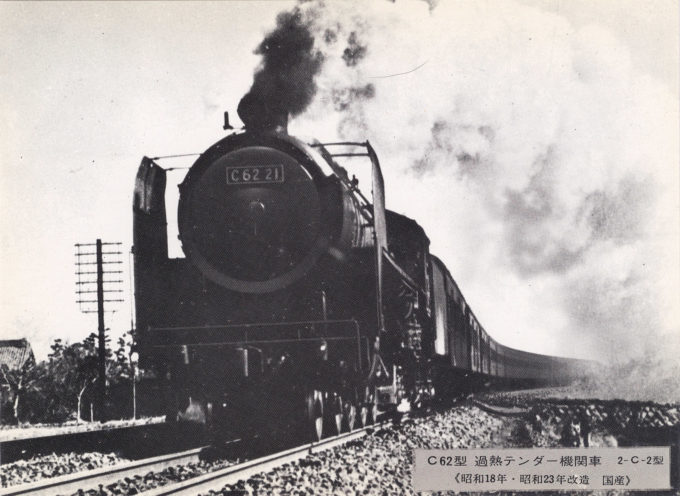
JNR Class C62. (1948-1973) The Class C62 was a type of 4-6-4 steam locomotive designed by Hideo Shima and built by the Japanese National Railways (JNR). These were the largest and fastest steam passenger locomotives to run in Japan, and hauled the Tsubame (Swallow) express on the Tōkaidō Main Line between Tokyo and Osaka. Forty-nine C62s were built from 1948 to 1949, with one remaining in service until 1973. Three examples are preserved at the Kyoto Railway Museum (with one in operational condition); two others are preserved as museum pieces, in Sapporo and Nagoya.


